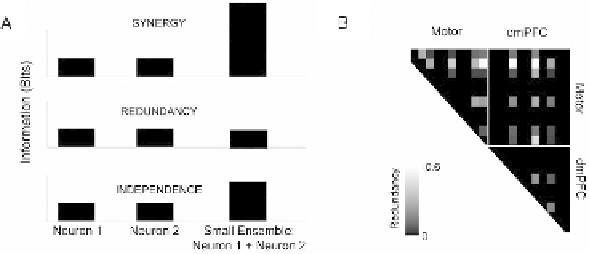Biomedical Engineering Reference
In-Depth Information
Fig. 7.9. Network interactions. (A) Two neurons predictive information can interact to
produce more information together than individually (synergy), less information together
than individually, or simply the linear sum together of their information individually
(independence). (B) Redundancy interactions across the ensemble; we observed almost
exclusively redundant interactions across the ensemble; note that this analysis is limited
only to neurons with significant predictive information.
predictive information of each neuron individually, then we would
call this an
independent
interaction.
Again, as with the previous section, the code for the pattern
recognition is complex; on the other hand, the computation of
whether neurons are synergistic, independent, or redundant is
simple
(14)
:
N
P
Ensemble
=
I
Ensemble
−
I
Neuron
1
Where
I
Ensemble
is the predictive information of the ensemble,
or two neurons together, and
I
Neuron
, is the predictive informa-
tion of individual neurons in the ensemble.
We applied this analysis to our population of neurons
recorded in dmPFC and motor cortex (
Fig. 7.9B
). First, we
found for 36 pairs with predictive information, the mean
P
ensemble
was -0.19 bits, suggesting overall redundant interactions. These
results are convergent with previous studies from out lab
(14)
.We
found that a
P
ensemble
of -0.2 corresponded to p
0. 05. Accord-
ing to these metrics, 13 (of 36 pairs; 36%) pairs had significantly
redundant interactions.
As an ensemble, we found that the population of neu-
rons in both areas (dmPFC and motor cortex) provided 0.55
bits of predictive information. Motor cortex alone provided 0.5
bits of information, while dmPFC alone provided 0.2 bits of
information. Thus combined, both areas had 0.15 bits of redun-
dancy (
P
ensemble
=
<
-0.15), below the significance level. These
results suggest a lack of strong synergistic or redundant interac-
tions
between
dmPFC and motor cortex.

